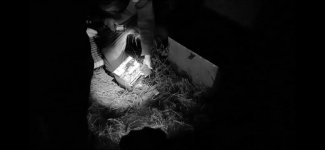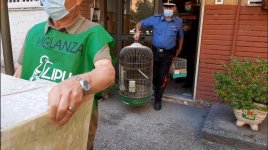dragnil
The glass is half full, but the bottle is empty.

Operation: Good night
Our anti-poaching tour makes a stop at Napoli to tell dramatic stories of LIPU guards: the night war on acoustic lures, and illegally-imprisoned goldfinches.Fabio Procaccini, LIPU Napoli delegate
In the shadow of Vesuvius
The night silence is broken by the call of quail, electromagnetic quail or “fonofil’, an unwelcome welcome for unsuspecting Wuail (Coturnix coturnix). We normally set up watch hoping to catch the poachers red-handed, but this time we are going for a bigger raid. Two nights of intensive work to find and confiscate as many lures as we can find from the countryside below Vesuvius. It is the start of Operation Good Night. It is May 2021.
The old stone tower
Three cars, ten passengers, all LIPU guards and volunteers. Giuseppe Salzano, veteran and regional co-ordinator, opens a map and points out our destinations. We line up in convoy and leave for the back lanes, the darkness broken by headlamps of distant cars. We stop, get out, and prick our ears, trying to catch the sound of calls in the distance, but the barking of stray dogs that roam the plain gets in the way. Then we hear it. Distant. Pinpointing the source we climb back into our cars, those who know the area leading the way. Here we are, the calls becoming clearer and stronger, from the middle of a field, from an old stone tower. Fired up by shared adrenaline we continue on foot, torch in hand. We find the device pretty quickly, turn it off, dismantle it, then remove it; our youngest handling the heavy car battery with ease.
How many?
We soon hear other calls. The night is going in the right direction. Arriving at an open space, we leave two people behind with the cars while the others search for malicious devices, their torches pointed at the ground. The vegetation is tall, hiding dangers in its darkness. The fastest of us quickly reaches the objective, the call coming from the middle of a field. We deactivate the lure but then hear two more from different directions and close by. Moving on, we reach the foot of a tree, a loudspeaker hidden up in the leaves. Two of our youngsters will see to that. Leaning back against the trunk, one folds his legs to make a step; the other takes a pace back then launches forward, using the step as a springboard to jump up, catch a branch, and climb the tree. He reaches the loudspeaker and lets it fall. We follow the cable back from the horn to the lure. The cable ends at a large iron box secured by a thick padlock, the precious device hidden inside. We came fully prepared: crowbar, flex, and the certainly-not-to-be-forgotten lump hammer. We land heavy blows on the padlock, the noise filling the air. At last the padlock opens and there is a rush of almost childish curiosity to view the contents: a car battery, calling device, and pen drive, skilfully put together. We dismantle the lot, but now the other call has stopped. Surprise! - it wasn’t a lure at all, but a real quail that had arrived in the night.
We start out again, but soon receive an SOS from one of our cars that has broken down, an old Panda whose gear lever has unhooked itself on the bumpy tracks. We arrive quickly. One of our team, Antonio, is a capable auto-mechanic. Lying on his back he slides under the Panda, and in a few seconds the car is fixed, ready to continue.
At the end of two nights work we have dismantled and seized nine lures. The sweep has not gone unnoticed, either by the hunters or by the locals who can finally rest from the incessant call of mechanical quail. We sigh with relief, for the moment at least.
Operation: Noah
June 2021. I receive a lot of calls for help, mostly from people who have found young chicks. But some calls are different. Like when a caller, choosing to remain anonymous, provides the address of a flat where wild birds are being kept illegally.
As usual I go and assess the situation. Finding the flat, I locate the balcony where I can see many cages, but at this distance I can’t recognise the species. Two of the cages are larger, undoubtedly containing a pair of jays. The birds look very agitated, the typical behaviour of wild animals captured and confined. There is clear evidence of crime.
From canaries to tortoises
We assemble a team and return, alerting the flying squad of Carabinieri at Napoli who quickly join us. We start the search. A sixty-something collector, serial accumulator of birds, has several pairs of canaries and cockatiels (parrots), and is illegally keeping a pair of jackdaw, wood pigeon and jay, as well as two pairs of quail, a blackbird, a robin, a corn bunting and a pair of Hermann's tortoise. On the balcony we also find an activated cage trap. All the birds have been confiscated and moved to the CRAS of ASL Napoli 1 to be set free later. The man has been reported to Napoli prosecutors for the detention and maltreatment of captured animals, and for the poaching of birds.
Domino effect: the goldfinches of Somma Vesuviana
The reports continue to come in, now more frequent and more detailed. As people begin to trust us they start to provide details of houses where protected birds are being hidden.
This time it is goldfinches that are being kept at a property in Somma Vesuviana, inside the boundary of the Vesuvius National Park. Two of our guards in plain clothes go to investigate. They study the route, access points, and prepare all the information we need to organise a raid. It is a semi-detached property from which they can clearly hear the song and calls of goldfinches.
We go talk to the park Carabinieri at Ottaviano who cover this area. We know the commandant well; he welcomes us, listens to us, checks the roster, and makes plans for the following day.
The raid
Arriving at the barracks on the dot, we set out for our objective. The Carabinieri ring the bell and the door opens. On entering we immediately see small cages scattered round the outer courtyard, mostly holding goldfinches. A man, clearly tense and worried, walks up to us. The car outside, in the green livery of the park Carabinieri advertises the reason for our visit. The man is 63-years old with a passion for goldfinches. He offers no resistance, but tries to minimise his crime with the usual excuses. We carry out a search, finding some nine goldfinches, a song thrush, and a siskin.
Now free
We take the eleven birds at once to the wild animal recovery centre (CRAS) of ASL Napoli 1 to be looked at by a vet before being set free. Immediate release isn’t always wise as some birds can become adapted to life in cages and are unable to survive if returned to the wild too soon. For these cases we gradually re-introduce the birds to flying, putting them in progressively larger areas before their final release.
The fight against illegal activities in the Napoli area is demanding, difficult, and tiring, but the determination and skills shown by LIPU guards and the forces of order are more than a match for the situation they face. Now the new hunting season is upon us. The poachers, with their lures and all the rest of it, have been warned.







